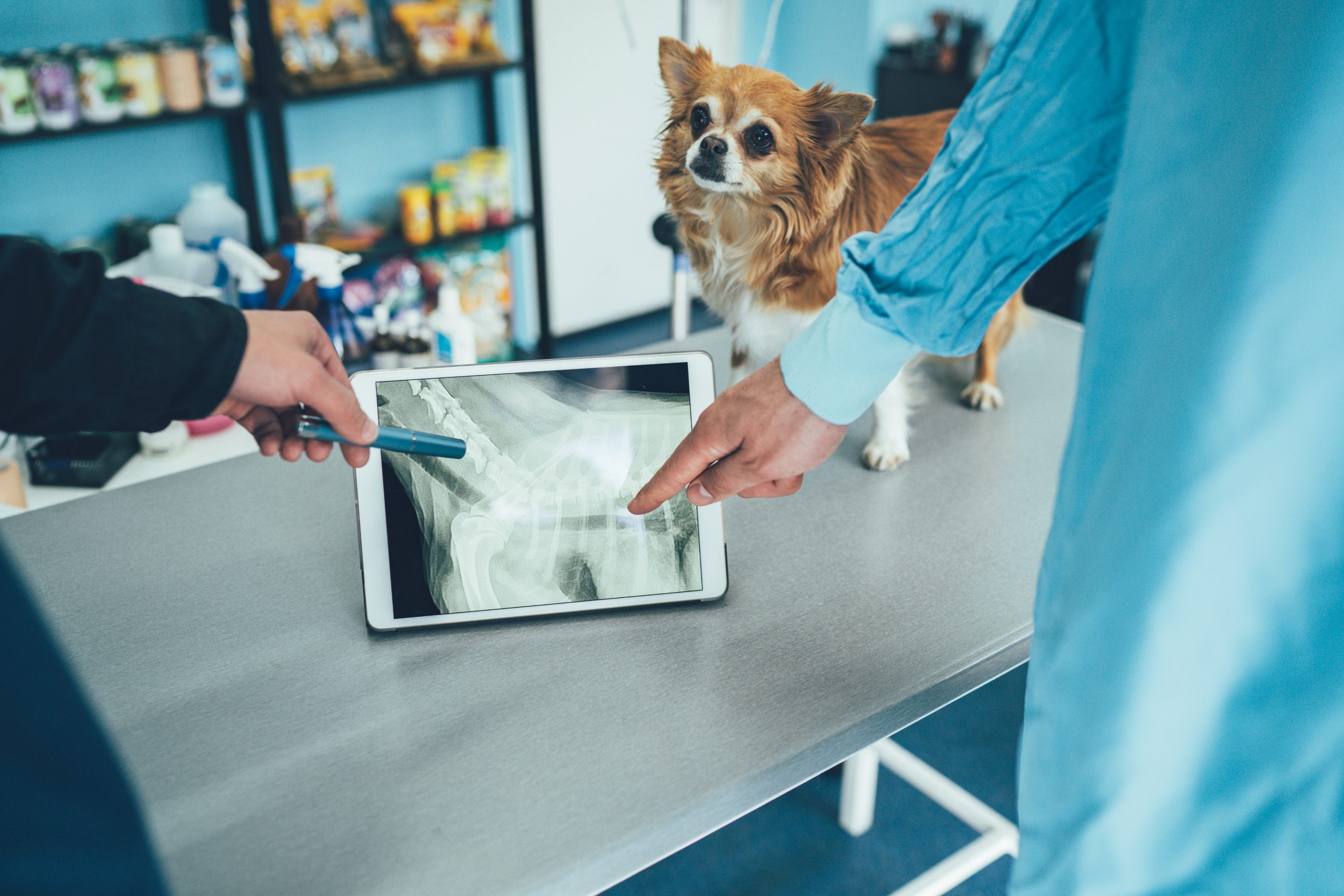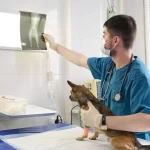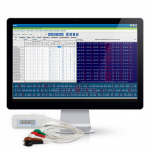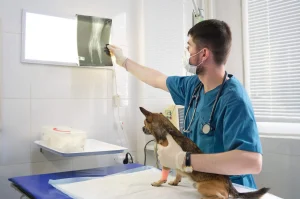
Artificial intelligence (AI) is making strides in veterinary teleradiology, offering new and exciting tools to assist veterinary radiologists in interpreting diagnostic images. However, as with any technology, it comes with both benefits and potential challenges. Here’s a closer look to help general practitioners make informed decisions about incorporating AI into their practices.
What Is AI in Veterinary Teleradiology?
AI in veterinary teleradiology involves machine learning algorithms that are typically trained on thousands of radiographic images to identify patterns, detect abnormalities, and assist in interpreting diagnostic images. These systems are designed to detect abnormalities, suggest possible diagnoses, and support radiologists and veterinarians in making clinical decisions. Some systems available on the market will generate a complete report without input from a board-certified radiologist. It has the potential to be a valuable tool to enhance efficiency and support general practitioners in their diagnostic process.
Benefits of AI in Veterinary Teleradiology
Faster Turnaround Times
- AI can process and analyze images quickly, potentially reducing the time it takes to identify abnormalities. This can allow veterinarians to make more timely decisions in urgent cases, such as trauma or respiratory distress.
Improved Diagnostic Accuracy
- AI algorithms are trained to recognize subtle abnormalities that might be missed during a busy day.
- AI provides another layer of analysis that can act as a first-line tool for detecting abnormalities to later be reviewed by a radiologist. AI systems serve as a “second set of eyes,” reducing the risk of diagnostic errors.
Enhanced Workflow Efficiency
- By pre-screening images and highlighting areas of concern, AI streamlines the diagnostic process.
- Veterinarians can focus their time on treatment planning and patient care instead of lengthy image analysis.
Consistency
- AI algorithms are less influenced by fatigue or bias when properly maintained, potentially offering more consistent evaluations.
Learning Opportunities
- For less experienced veterinarians, AI can highlight areas of concern and provide insights that improve their diagnostic skills.
Accessibility for General Practices
- Practices without access to on-site radiologists or specialists can leverage AI tools to obtain preliminary interpretations.
- Combined with teleradiology, AI ensures that even remote practices can offer advanced diagnostic capabilities.
Practical Applications of AI in Teleradiology
Disease Detection
- AI can be used for the identification of common conditions in veterinary radiology, such as fractures, pulmonary patterns, cardiomegaly, abdominal masses, foreign objects, and more.
Prioritization of Cases
- AI can flag critical cases for priority review by a radiologist, ensuring that urgent conditions are addressed promptly and cases are triaged appropriately.
Increased Efficiency
- Time Savings:
- Case Prioritization: AI can flag urgent cases, ensuring that critical patients are reviewed first.
Enhanced Diagnostic Support
- Second Opinion:
Consistency in Analysis
- Objective Assessments: AI algorithms are less influenced by fatigue or bias when properly maintained, potentially offering more consistent evaluations.
Learning Opportunities
- Educational Value: For less experienced veterinarians, AI can highlight areas of concern and provide insights that improve their diagnostic skills.
Risks and Challenges of AI in Veterinary Teleradiology
Accuracy Limitations
- Errors in Interpretation: AI systems can produce false positives or negatives, which may lead to unnecessary follow-ups or missed diagnoses. This is especially a risk for systems that do not employ a human radiologist to review the AI findings.
- Dependence on Data: The quality and diversity of the dataset used to train AI significantly impact its performance. Limited datasets may result in reduced accuracy, particularly for uncommon conditions or species.
- Radiologist Oversight Required: AI should always be used in conjunction with a veterinary radiologist to confirm findings and provide nuanced interpretations.
Lack of Contextual Understanding
- No Integration of Clinical History: AI analyzes images in isolation and cannot consider patient history, physical exam findings, or other diagnostic tests.
- Oversimplification of Complex Cases: Certain conditions require a nuanced approach that AI is not yet equipped to provide.
Overreliance on Technology
- Potential for Complacency: There’s a risk that veterinarians may overly depend on AI and overlook their own critical thinking or expertise.
- Reduced Specialist Input: In some cases, AI might discourage the use of specialist consultations, which could limit comprehensive diagnostic evaluations.
Ethical and Legal Considerations
- Accountability: Determining liability in cases where AI contributes to errors is a developing area of concern and has yet to be thoroughly tested within the court system.
- Transparency: Veterinarians and clients may need clear explanations of how AI reaches its conclusions to maintain trust. They may also need clear explanations of how AI was employed in the diagnosis and treatment of the patient.
How AI Fits into Veterinary Practice
Complement, Not Replacement
AI is best used as a supportive tool alongside human expertise. While it can improve efficiency and accuracy, it should not replace the judgment of veterinarians or radiologists.
Training and Familiarity
Veterinarians need training to understand AI’s capabilities and limitations, ensuring it’s used effectively without overreliance.
Gradual Adoption
Starting with AI for routine cases or preliminary assessments can help practices evaluate its value without disrupting workflows.
The Future of AI in Veterinary Teleradiology
AI continues to evolve, and its role in veterinary medicine will likely expand. Improvements in algorithm accuracy, integration with clinical decision-making tools, and increased availability of diverse training datasets may make AI more reliable over time. However, at this stage it’s crucial to remain cautious and continually assess its performance.
In Summary
AI in veterinary teleradiology has the potential to enhance diagnostics, streamline workflows, and improve patient care. However, it’s not without its challenges, including accuracy limitations and ethical considerations. By approaching AI with a balanced perspective—recognizing its strengths and understanding its risks—general practice veterinarians can determine how best to integrate this technology into their practice.




